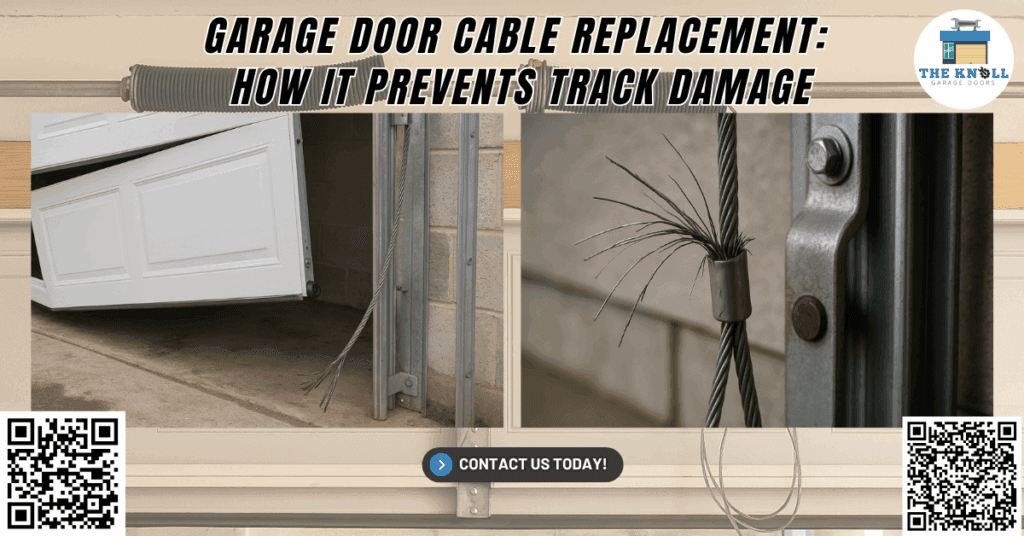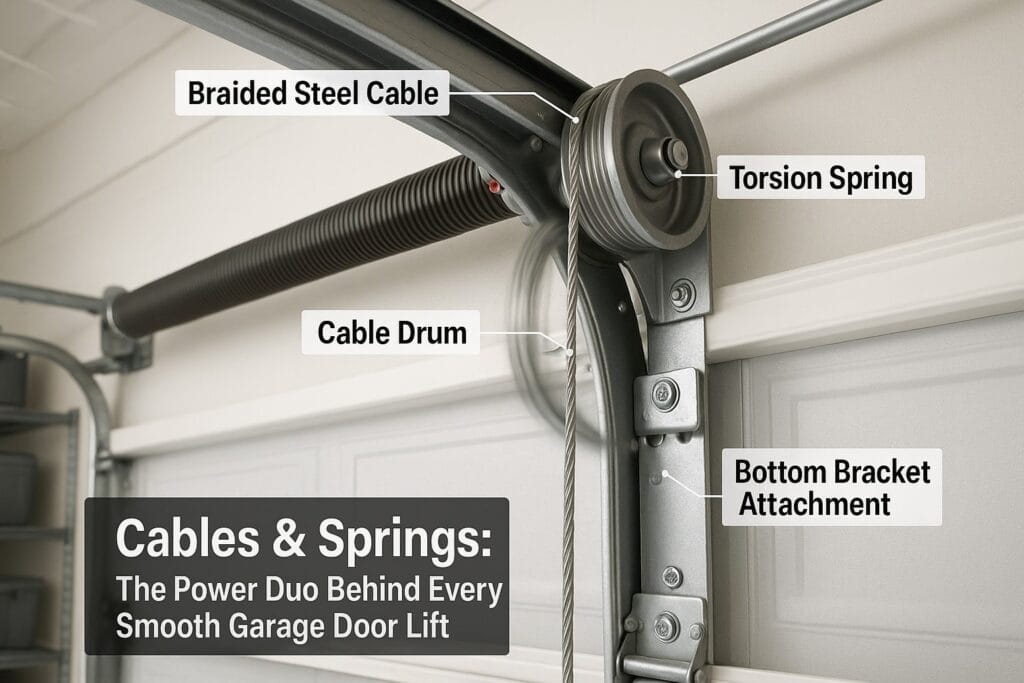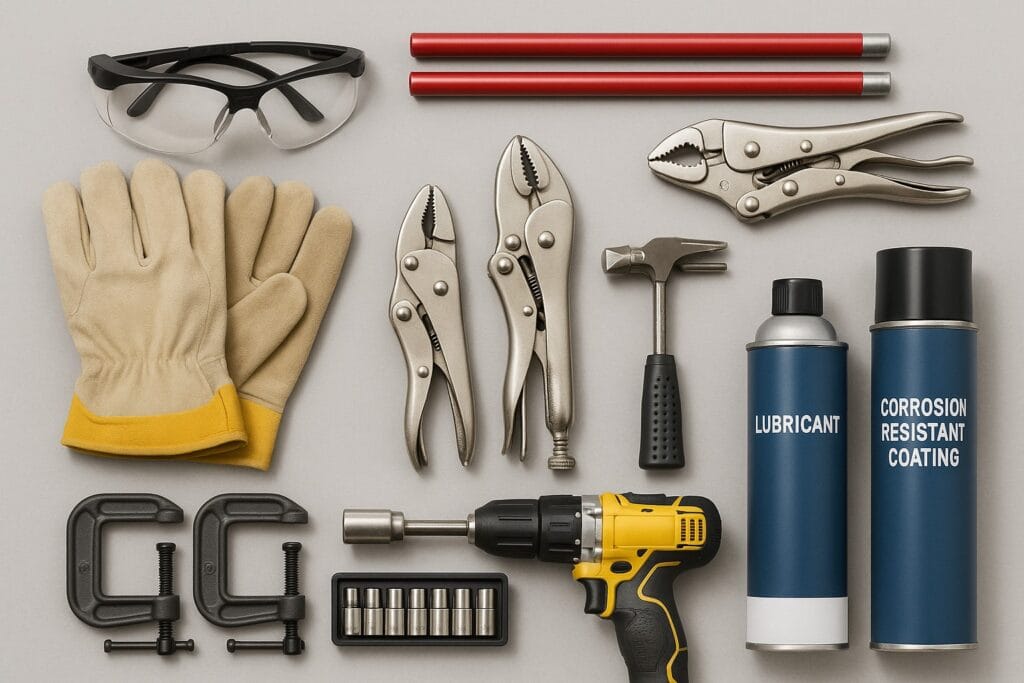Garage Door Cable Replacement: How It Prevents Track Damage

One chilly spring morning in College Station, a homeowner found herself trapped in her garage. Her garage door refused to open, hanging crooked and jammed halfway up the track. When our team at The Knoll Garage Doors arrived, we quickly discovered that a broken cable was to blame. The door’s weight had shifted unevenly, causing the rollers to slip out of place and the track to bend. Fortunately, we were able to replace the damaged cable, realign the track, and restore smooth, safe operation, but this common issue could have been avoided with timely maintenance.
According to Garage Door Nation, over 30% of garage door system failures stem from issues with door cables. These thin yet strong garage door parts bear tremendous weight and tension every time you open or close the door. When they wear down or snap, they can cause widespread damage to the garage door system, especially the tracks, rollers, and even the garage door opener.
In this comprehensive guide, we’ll explain how garage door cable replacement plays a crucial role in protecting your garage door track and ensuring safe operation. You’ll learn what the cables do, how they wear out, what signs to watch for, and how professional garage door service from The Knoll Garage Doors can help keep your garage door system in top shape. Whether you’re dealing with a broken garage door or simply want to extend the life of your system, this article will give you the step-by-step guide and expert insights you need.
What Are Garage Door Cables?
Garage door cables are heavy-duty wires made from braided steel, designed to handle extreme tension and support the weight of the garage door. These cables connect to either torsion springs or extension springs, depending on your garage door system. As the door opens and closes, the cables wrap and unwrap around cable drums (in torsion systems) or run through pulleys (in extension systems) to assist in lifting and lowering the door safely.
These garage door parts work in unison with other components like the springs, bottom brackets, and garage door opener to allow smooth, balanced movement. Without functioning cables, the system loses its balance and poses a serious safety risk. In Henderson and other universal door brands, these parts are manufactured to specific tolerances, meaning even a slightly frayed or stretched cable can affect the system’s performance. Because of the high tension involved, cables must be installed and replaced with professional help and the right tools to avoid injury.

Why Garage Door Cables Wear Out
Garage door cables are built to last, but they’re not indestructible. Daily use, weather exposure, and age all contribute to wear and tear. Over time, the repeated winding and unwinding of the cables around the drum, along with constant spring tension, can cause the metal to corrode, weaken, or even fray. In humid climates like College Station, rust and corrosion are common culprits, especially if the garage door isn’t part of a regular maintenance routine.
Other factors like misaligned rollers, poor track alignment, or improper installation of the garage door opener can also place uneven stress on the cables, causing premature failure. In some cases, homeowners unknowingly worsen the problem by pulling on a malfunctioning door, further stressing the garage door system. Once the cables begin to fray, it’s only a matter of time before one snaps, and when it does, the door can drop suddenly or slip off its track, leading to extensive repairs.
That’s why regular inspections and garage door maintenance are essential. Spotting a small issue early, like a worn section of cable, a loose bolt, or unusual movement, can save hundreds of dollars in garage door repair costs down the road.
How Failing Cables Damage Garage Door Tracks
Many homeowners don’t realize how interconnected every part of the garage door system is until something breaks. When a garage door cable starts to fail, the consequences often extend beyond the cable itself, especially to the track.
1. Door Sags on One Side
When one cable stretches or snaps, the door becomes unbalanced. It may tilt to one side or hang unevenly when opening or closing. This imbalance places uneven pressure on the garage door tracks, causing them to bend or shift out of alignment.
2. Door Slips Off the Track
A garage door that’s not properly supported can derail entirely. When a cable breaks, the door may slam down suddenly or get stuck mid-operation. The rollers can jump off the track, forcing the entire system to halt and requiring immediate professional repairs.
3. Bent or Warped Tracks
As the door struggles to move with only one functioning cable, it often scrapes or presses into the track at awkward angles. This can cause visible bends in the metal, warping the track and making it difficult for new rollers or cables to work properly until the track is replaced.
4. Damage to Other Parts
When the door can’t move freely, extra strain is placed on the garage door opener, brackets, torsion springs, and even the hinges. A broken cable becomes the root cause of a chain reaction that accelerates damage throughout the garage door system.
5. Safety Hazards
Beyond mechanical issues, there’s a real risk of injury. A door that drops or gets jammed due to a cable failure can crush objects, or worse, harm people or pets. That’s why identifying signs of cable damage early is essential for safe operation.
Signs You Need a Garage Door Cable Replacement
Your garage door may be trying to tell you something is wrong if you know what signs to look for. Here are some red flags that it’s time for a cable replacement:
- Fraying or Rust: Check both sides of the door for visible signs of cable wear, including rust, frays, or broken wire strands.
- Slack Cables: If the cables appear loose when the door is closed, they may have stretched or disconnected from the bottom bracket.
- Uneven Movement: If one side of the door rises faster or slower than the other, it’s a strong sign that one cable is failing.
- Grinding or Popping Sounds: Noises during operation could indicate that the cables are rubbing against the drum or that a roller is misaligned.
- Crooked Door or Jammed Track: A tilted or stuck door often points to cable imbalance or damage.
- Door Slams Shut: A sudden slam may occur if both cables lose tension or one completely breaks.
If you notice any of these signs, contact a garage door professional immediately. Continuing to operate the garage door under these conditions can lead to serious damage or personal injury.
Benefits of Timely Garage Door Cable Replacement
Proactive garage door cable replacement is one of the smartest investments you can make in your home’s safety and functionality. Here’s why:
✔ Prevents Track Damage
Replacing old cables before they break helps keep your garage door aligned and moving smoothly. Balanced tension on both sides reduces strain on the track, preventing misalignment, bending, or derailment.
✔ Saves Money on Repairs
Fixing a single cable is relatively inexpensive. Waiting until that failure causes damage to the track, opener, or springs can cost hundreds of dollars in garage door repairs.
✔ Enhances Safety
With garage door springs and cables under high tension, sudden failures can cause doors to crash down unexpectedly. Timely replacement ensures safe operation for your family, pets, and belongings.
✔ Improves Performance
New cables improve how the door operates. You’ll notice smoother, quieter movement and less resistance from the garage door opener, which helps extend the life of your motor and other moving parts.
✔ Extends the Lifespan of Your Garage Door
Regular maintenance and timely cable replacement ensure that all parts of your garage door system wear evenly. This prevents premature breakdown and extends the life of your entire setup.
Why Garage Door Cable Replacement Requires Professional Help
Replacing garage door cables is not a DIY task, it’s a high-risk repair that involves dangerous spring tension. Without the right tools, training, and safety precautions, you could be putting yourself at serious risk.
⚠ High Tension Dangers
Both torsion springs and extension springs are under extreme pressure. Mishandling them can result in a sudden snap, whipping cables, or flying parts that can cause severe injury.
⚠ Risk of Improper Installation
Even if you manage to remove the old cables, installing new ones incorrectly can lead to imbalance or even more damage. Garage door systems require precise calibration for safe and effective operation.
⚠ Hidden Problems
Professional technicians don’t just replace cables, they inspect the entire system for other issues, such as worn rollers, loose bolts, or misaligned tracks, ensuring everything works in harmony.
⚠ Personal Protective Equipment (PPE)
Pros come equipped with safety glasses, gloves, and specialized tools to perform the task safely. Without PPE, homeowners are vulnerable to unexpected accidents.
When it comes to handling high-tension systems, always call a professional garage door expert.

The Knoll Garage Doors’ Cable Replacement Process
At The Knoll Garage Doors, we’ve perfected a step-by-step process that ensures your garage door cable replacement is done right the first time:
- Initial Inspection
Our certified technicians assess the full garage door system, identifying frayed cables, loose bolts, or signs of track damage. - Tension Release
Using professional-grade tools, we safely release spring tension before removing the old cables, following all safety procedures. - New Cable Installation
We install high-quality galvanized steel cables, matched to your door type and system, whether it uses torsion or extension springs. - Rebalancing & Alignment
Once installed, we test and calibrate the cable tension, ensuring smooth, even door movement and a perfectly aligned track. - Final Safety Check
Before leaving, we check the opener, springs, and rollers, and provide recommendations for future maintenance to keep your system running like new.
How to Prevent Garage Door Cable Damage
Preventing garage door cable problems starts with routine maintenance and smart habits. Here are practical tips to avoid cable failure:
- Schedule Regular Inspections: Have your garage door system checked annually by a professional to catch early signs of wear.
- Lubricate Moving Parts: Apply silicone-based lubricant to rollers, drums, and springs to reduce friction and prolong life.
- Avoid Excess Moisture: Prevent corrosion by keeping your garage dry and checking for rust on metal components.
- Don’t Force a Stuck Door: If your garage door gets stuck, don’t yank it. Call a professional to inspect for cable issues or track misalignment.
- Watch for Early Warning Signs: Listen for strange noises, look for visible fraying, and test for balance regularly.
How Can The Knoll Garage Doors Help You?
If you’re experiencing problems with your garage door cables, don’t wait for a minor issue to become a major repair. At The Knoll Garage Doors, we provide fast, reliable, and affordable cable replacement services in College Station, TX, and the surrounding areas. Whether you’re dealing with a broken garage door, uneven movement, or just want a routine inspection, our team is ready to help.
📍 Visit Us: 2322 Texas Ave S, College Station, TX 77840
📞 Call Now: (979) 978-0221
Our trained professionals handle everything from garage door opener repairs to full garage door system overhauls. We work with top brands like Henderson, Garador, and Universal Doors, and we always bring the right tools, PPE, and expertise to get the job done safely and efficiently.
Final Thoughts
Your garage door cables are small, but they do heavy lifting every day. When they start to wear out, they quietly put your garage door system and your safety at risk. By understanding the signs of cable failure, taking preventive steps, and seeking professional help from a trusted local provider like The Knoll Garage Doors, you can avoid costly track damage and keep your system operating smoothly.
Remember, proactive cable replacement isn’t just about avoiding repairs, it’s about ensuring your home stays safe, your routines stay uninterrupted, and your investment lasts for years to come. Call us today to schedule your garage door cable inspection or replacement service, because the best time to take action is before problems start.
Frequently Asked Questions (FAQs)
1. How often should garage door cables be replaced?
Garage door cables typically last 7 to 10 years with normal use, but their lifespan depends on climate, maintenance, and frequency of operation. If your garage is used multiple times daily or exposed to moisture, it’s best to have it inspected annually and replaced sooner if signs of wear appear.
2. Can I replace garage door cables without replacing the springs?
Yes, you can replace the cables without changing the springs, but both components work closely together. If your springs are old or showing signs of fatigue, it’s often safer and more cost-effective to replace them at the same time.
3. Are all garage door cables the same size?
No, garage door cables vary in length, diameter, and strength depending on the door’s weight, height, and spring type (torsion or extension). Using the wrong size can cause serious performance and safety issues, so always use cables that match your system specifications.
4. What happens if both garage door cables snap at once?
If both cables snap, the door may crash down suddenly or become completely inoperable. This creates a major safety risk and should be addressed immediately by a professional to avoid injury or further system damage.
